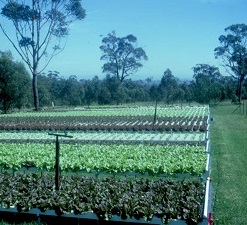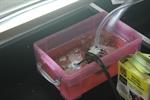 You Can always Learn More
You Can always Learn More
Hydroponics is a more sophisticated way of growing plants than growing in the ground. This makes it more complicated, requiring greater knowledge, more equipment and more money to establish (per acre); but it also offers the potential of more control over the plant growth, and greater productivity (per acre).
Hydroponics is not for everyone, or every place; but in some places, being managed by the right people, it may be the best and least risky way of growing crops.
This course assumes a foundation knowledge in hydroponics. If you have already completed one of our courses; or have significant experience, this may well help you take your abilities to the next level.
Course Content and Structure
There are eight lessons in this course as follows:
1. Options for Managing Plant Culture - different approaches to cultural operations in hydroponics. Organics vs. hydroponics:Nutrient differences in food products. Is hydroponic food more or less healthy than organic? How feasible is organic hydroponics?
2. Planning a Hydroponic Operation - site and crop selection; matching a system with a crop, materials, resources & services required.
3. System Design Components - pumps, hardware, media, pipes, size, type, and so forth. Components for different types of culture.
 4. Managing a Hydroponic System in Hot, Humid Conditions - tropical and subtropical climates or summer in temperate areas.
4. Managing a Hydroponic System in Hot, Humid Conditions - tropical and subtropical climates or summer in temperate areas.
5. Water Management - water quality measures, treatments, runoff,testing, purifying water, water in recirculating and run-to-waste systems.
6. Nutrient Formulation - standard formulations, detecting toxicities & deficiencies.
7. Controlling Nutrient Levels - using EC and pH measures of concentration levels, solution temperatures, and maintaining nutrient levels.
8.Pest & Disease Control - nutrient and pH manipulation for control of pests & diseases, integrated pest management, common pests and diseases.
Course Aims
- Describe different approaches to cultural operations
- Demonstrate an awareness of similarities and differences between organic and hydroponic production techniques
- Describe how to plan a hydroponic operation through site and crop selection, matching a specific crop, materials, resources and services required, and site layout; for different specific crops.
- Discuss system design components such as pumps, grow beds, solution tanks, media and pipes in terms of size, type, and options for different cultures and specific crops.
- Provide details of how to manage a hydroponic system in hot, humid conditions such as in tropical or subtropical areas, or in summer, in temperate areas, for specific crops.
- Explain options for water management such as water sources, quality, testing, treatments, and use in recirculating and non recirculating systems.
- Recommend awareness of natural and other methods of pest and disease control such as biological controls, as part of IPM and nutrient and pH manipulation for different pests and diseases.
- Explain and recommend different standards of nutrient formulation, and advanced methods of detecting toxicities and deficiencies in specific crops.
- Recommend methods to control nutrient level concentrations by taking EC, pH and temperature measurements, and maintaining nutrient levels for different specific crops
Course Duration: 100 hours of self paced study
Commercial Hydroponic Ventures Need Good Water Supplies

Before any commercial hydroponic installation is planned, it is important to fully investigate the quality of the water onsite and a complete water analysis is required for this process. Water samples can be sent to agricultural/horticultural analytical laboratories for a standard or routine water profile. Many labs carry out water sample analysis and a standard drinking water analysis will be fine in most cases as it will give levels of minerals, pH and other useful variables which can be used to determine if the water is suitable for the crop to be grown. When water is sent for a standard drinking water analysis, the results may include comments on the suitability of the water for humans – these can be disregarded as water for hydroponics has different requirements than drinking water.
Water samples should be collected from the water source, sealed in a clean plastic bottle (some labs provide their own sample bottles for this) and sent immediately to the lab for testing. Most labs require 500ml to 1 litre of representative water sample. The lab should test for as many of the following variables as possible:
pH, EC or TDS (total dissolved solids), total alkalinity, carbonate, bicarbonate nitrate, phosphorus, potassium, calcium, magnesium, sulphate, sodium, chloride, iron, manganese, boron, zinc, copper.
MEET OUR EXPERTS
|
|
|
|
John L. Mason Dip.Hort.Sc., Sup'n Cert., FIOH, FPLA, MAIH, MACHPER, MASA
Author of the best selling book "Commercial Hydroponics", started teaching and practicing hydroponics in the early 1970's. Has worked across many areas of horticulture for 45 yrs; garden editor for Home Grown Magazine.
|
Dr Lynette Morgan B.Hort.Tech(Hons), PhD in hydroponic greenhouse production
Partner in SUNTEC International Hydroponic Consultants, Lynette is involved in many aspects of hydroponic production, including remote and on site consultancy services for new and existing commercial greenhouse growers worldwide as well as research trials and product development for manufacturers of hydroponic products. Lynette is also the author of 6 hydroponic technical books
|
Bob James QDAH. B. Applied Sc(Hort Tech),Grad Dip. Mgt, M;Sc (Enviro Sc.), PDC.
Bob has over 50 years experience in Government and Private Horticulture and Environmental Management Consulting.
|
How Feasible is Organic Hydroponics?
People do grow plants in hydroponics organically, and in some places, it is even possible to get organic certification for crops grown organically. Organic hydroponic growing is however a little different to more traditional hydroponic growing though.
 Whichever way you intend growing; there are things that can be learned by studying both. Comparing the two ways, can help us understand hydroponics better, and for that reason, if no other; that is why this course covers both.
Whichever way you intend growing; there are things that can be learned by studying both. Comparing the two ways, can help us understand hydroponics better, and for that reason, if no other; that is why this course covers both.
Organic hydroponics is perfectly possible, but it does rely on converting organic compounds into plant usable nutrient ions via the action of microbes. Whether a plant is obtaining nutrients from a traditional non organic nutrient solution or via organic fertilisers makes no difference to plant uptake – the root system absorbs the exact same mineral ions in both systems. However in the organic system the nutrient ions first have to be released from organic materials, while in hydroponics we supply the nutrient ions directly via the fertilisers dissolved into solution. This microbial conversion process occurs naturally in soil, however in soil-less systems it needs a helping hand to speed up the process and keep it ticking over so that rapid plant growth is always supplied with sufficient nutrients at the right time.
Most commercial organic hydroponic growers use an organically certified liquid fertiliser blend – there is huge number of these to chose from, and larger growers often need to blend 2 or more of these to get the balance of nutrients just right for the crop they are growing. On top of this, the liquid fertiliser products may need some amendment and luckily organic production does allow for the use of some fertiliser salts, so organic hydroponic plants are not totally reliant on organic compounds. These allowable fertilisers have to be `naturally occurring’ and there are a good range of these which can be used to boost the mineral content of organic nutrient solutions. Some of the allowable fertiliser salts are: Boron (Borax and solubor), Calcium carbonate, Copper sulphate, dolomite, Iron sulphate, magnesium sulphate, manganese sulphate, potassium sulphate (non synthetic) and potassium chloride. Fertilisers which are considered `synthetic’ such as calcium nitrate, potassium nitrate and monopotassium phosphate which make up much of the volume of a standard hydroponic nutrient are not allowable.
 Nutrient additives and boosters for organic production are wide and varied, however humic and fulvic acids are organically allowable and are well known beneficial supplement for hydroponics.
Nutrient additives and boosters for organic production are wide and varied, however humic and fulvic acids are organically allowable and are well known beneficial supplement for hydroponics.
Smaller growers are best starting by incorporating an organically appropriate substrate. This substrate gives a good degree of `buffering’ capacity to the system and provides a more ideal environment for the nutrient conversion microbes which form the basis of the system. Organically allowable growing substrates are listed by OMRI, however many growers have found coconut fibre to be ideal and it is one many hydroponic gardeners are already familiar with. Cocofibre for use in organic production can’t have had any synthetic materials added to it, including `conditioning’ fertilisers or surfactants and there is a list of OMRI certified coco products provided. Some brands of peat, perlite and vermiculite are also listed as OMRI certified with allows for flexibility in terms of blending a growing medium and using these as propagation materials. Many commercial organic growers blend coconut fibre with other materials such as composts or vermicast (worm castings) as these materials not only provide a small amount of readily available nutrients, but also a wide range of microbial species which can immediately start the nutrient conversion process when fed organic nutrient solutions.
Coco fibre for use in organic production can’t have had any synthetic materials added to it, including `conditioning’ fertilisers or surfactants, Some types of peat moss or other materials may also be appropriate. Many commercial organic growers blend coconut fibre with other materials such as composts or vermicast (worm castings).
The substrate forms the basis of any organic system, and to make sure it is going to perform well with organic nutrients, it can also be inoculated with one of the many microbial products which are organically allowable and this inoculation process is beneficial if continued through out the plant’s life. Beneficial microbe products for addition to the nutrient solution or drenched into the root zone have become common additives in hydroponics anyway, but they are even more essential when using organic solutions.
 Once plants are in place, the irrigation system needs to be run a little differently than traditional non organic hydroponics. Drip irrigation is advised as the root zone should never be over saturated with only a small volume of leachate from the base of the growing containers required. The root zone in organic systems is finely balanced between the requirements of the nutrient conversion microbes and the root system itself. Both require high levels of oxygenation and over watering excludes much of the aeration in the pores of the growing medium. Organic systems have a higher requirement for oxygenation in the root zone due to the heavy populations of microbes which are required, hence many failures with organic crops are directly attributable to over watering and/or poor aeration.
Once plants are in place, the irrigation system needs to be run a little differently than traditional non organic hydroponics. Drip irrigation is advised as the root zone should never be over saturated with only a small volume of leachate from the base of the growing containers required. The root zone in organic systems is finely balanced between the requirements of the nutrient conversion microbes and the root system itself. Both require high levels of oxygenation and over watering excludes much of the aeration in the pores of the growing medium. Organic systems have a higher requirement for oxygenation in the root zone due to the heavy populations of microbes which are required, hence many failures with organic crops are directly attributable to over watering and/or poor aeration.
EC and pH control in hydroponics is also different in organic systems. Many organic nutrients don’t conduct electricity, hence readings of EC may not be a true indication of the concentration of an organic solution. pH levels also tend to run higher in healthy organic systems than many growers are used to maintaining in standard hydroponics.
WHO BENEFITS FROM DOING THIS COURSE?
If you have experience in hydroponics - work in the field and want to take the next step in your career - then this course will benefit you. It is also for those enthusiasts who have either completed hydropnics 1 and 2 or who have a good general basic understanding of and experience in hydroponics but want to take it to the next level.